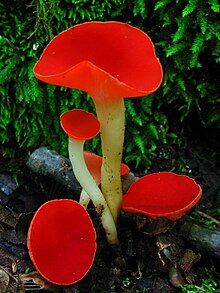
Sarcoscypha is a genus of ascomycete fungus and a type genus of the family Sarcoscyphaceae. Species of Sarcoscypha are present in Europe, North America and tropical Asia. They are characterised by a cup-shaped apothecium which is often brightly coloured. They have had a range of popular uses, one of which was as a table decoration. Some members of the family such as S. coccinea and the - according to new knowledge - more common S. austriaca in western Europe and United States have bright scarlet apothecia which have given them familiar names such as the scarlet cup fungus and scarlet elf cap.
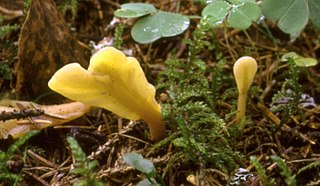
Spathularia flavida, commonly known as the yellow earth tongue, the yellow fan, or the fairy fan, is an ascomycete fungus found in coniferous forests of Asia, Europe and North America. It produces a small, fan- or spoon-shaped fruit body with a flat, wavy or lobed cream to yellow colored "head" raised on a white to cream stalk. The height is usually approximately 2–5 cm, and up to 8 cm. The fungus fruits on the ground in mosses, forest duff or humus, and fruit bodies may occur singly, in large groups, or in fairy rings. The spores produced by the fungus are needle-like, and up to 95 micrometres long. Several varieties have been described that differ largely in their microscopic characteristics. S. flavida has been described by authorities variously as inedible, of unknown edibility, or edible but tough.
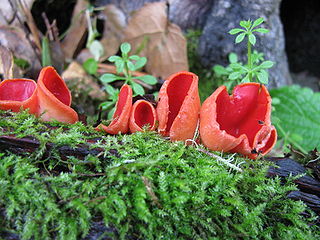
Sarcoscypha coccinea, commonly known as the scarlet elf cup, or the scarlet cup, is a species of fungus in the family Sarcoscyphaceae of the order Pezizales. The fungus, widely distributed in the Northern Hemisphere, has been found in Africa, Asia, Europe, North and South America, and Australia. The type species of the genus Sarcoscypha, S. coccinea has been known by many names since its first appearance in the scientific literature in 1772. Phylogenetic analysis shows the species to be most closely related to other Sarcoscypha species that contain numerous small oil droplets in their spores, such as the North Atlantic island species S. macaronesica. Due to similar physical appearances and sometimes overlapping distributions, S. coccinea has often been confused with S. occidentalis, S. austriaca, and S. dudleyi.

Paragyromitra infula, commonly known as the hooded false morel or the elfin saddle, is a species of fungus in the family Discinaceae. The dark reddish-brown caps of the fruit bodies develop a characteristic saddle-shape in maturity, and the ends of both saddle lobes are drawn out to sharp tips that project above the level of the fruit body. The stipe is white or flushed pale brown, smooth on the outside, but hollow with some chambers inside.
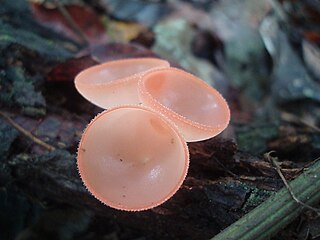
Cookeina is a genus of cup fungi in the family Sarcoscyphaceae, members of which may be found in tropical and subtropical regions of the world. Species may be found on fallen branches of angiosperms, trunks, and sometimes on fruits. The Temuans of Peninsular Malaysia are reported to use certain species from this genus as food, and also as a bait for fishing, where it is rubbed against the hook.

Geopyxis carbonaria is a species of fungus in the genus Geopyxis, family Pyronemataceae. First described to science in 1805, and given its current name in 1889, the species is commonly known as the charcoal loving elf-cup, dwarf acorn cup, stalked bonfire cup, or pixie cup. The small, goblet-shaped fruitbodies of the fungus are reddish-brown with a whitish fringe and measure up to 2 centimetres across. They have a short, tapered stalk.

Scutellinia scutellata, commonly known as the eyelash cup, the Molly eye-winker, the scarlet elf cap, the eyelash fungus or the eyelash pixie cup, is a small saprophytic fungus of the genus Scutellinia. It is the type species of Scutellinia, as well as being the most common and widespread. The fruiting bodies are small red cups with distinctive long, dark hairs or "eyelashes". These eyelashes are the most distinctive feature and are easily visible with a magnifying glass.

Chorioactis is a genus of fungi that contains the single species Chorioactis geaster. The mushroom is commonly known as the devil's cigar or the Texas star in the United States, while in Japan it is called kirinomitake (キリノミタケ). This extremely rare mushroom is notable for its unusual appearance and disjunct distribution; it is found only in select locales in Texas and Japan. The fruit body, which grows on the stumps or dead roots of cedar elms or dead oaks, somewhat resembles a dark brown or black cigar before it splits open radially into a starlike arrangement of four to seven leathery rays. The interior surface of the fruit body bears the spore-bearing tissue known as the hymenium, and is colored white to brown, depending on its age. The fruit body opening can be accompanied by a distinct hissing sound and the release of a smoky cloud of spores.
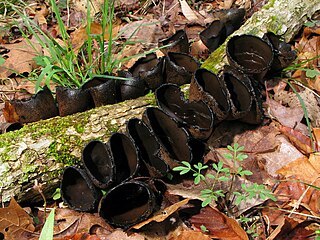
Urnula craterium is a species of cup fungus in the family Sarcosomataceae. It is parasitic on oak and various other hardwood species; it is also saprobic, as the fruit bodies develop on dead wood after it has fallen to the ground. Appearing in early spring, its distinctive goblet-shaped and dark-colored fruit bodies have earned it the common names devil's urn and the gray urn. The distribution of U. craterium includes eastern North America, Europe, and Asia. It produces bioactive compounds that can inhibit the growth of other fungi. The asexual (imperfect), or conidial stage of U. craterium is a plant pathogen known as Conoplea globosa, which causes a canker disease of oak and several other hardwood tree species.
Korfiella is a fungal genus in the family Sarcosomataceae. A monotypic genus, it contains the single species Korfiella karnika, found in India and described as new to science in 1970.

Plectania is a genus of fungi in the family Sarcosomataceae. It was circumscribed by German botanist Karl Wilhelm Gottlieb Leopold Fuckel in 1870.

Pseudoplectania is a genus of fungi in the family Sarcosomataceae. The genus contains 12 species. Pseudoplectania ryvardenii was described in 2012, while Pseudoplectania carranzae was transferred to the genus in 2013.

Microstoma floccosum is a species in the cup fungus family Sarcoscyphaceae. It is recognizable by its deep funnel-shaped, scarlet-colored fruit bodies bearing white hairs on the exterior. Found in the United States and Asia, it grows on partially buried sticks and twigs of oak trees.

Wynnea americana, commonly known as moose antlers or rabbit ears, is a species of fungus in the family Sarcoscyphaceae. This uncommon inedible species is recognizable by its spoon-shaped or rabbit-ear shaped fruit bodies that may reach up to 13 cm (5 in) tall. It has dark brown and warty outer surfaces, while the fertile spore-bearing inner surface is orange to pinkish to reddish brown. The fruit bodies grow clustered together from large underground masses of compacted mycelia known as sclerotia. In eastern North America, where it is typically found growing in the soil underneath hardwood trees, it is found from New York to Michigan south to Mexico. The species has also been collected from Costa Rica, India, and Japan.
Limnoperdon is a fungal genus in the monotypic family Limnoperdaceae. The genus is also monotypic, as it contains a single species, the aquatic fungus Limnoperdon incarnatum. The species, described as new to science in 1976, produces fruit bodies that lack specialized structures such as a stem, cap and gills common in mushrooms. Rather, the fruit bodies—described as aquatic or floating puffballs—are small balls of loosely interwoven hyphae. The balls float on the surface of the water above submerged twigs. Experimental observations on the development of the fruit body, based on the growth on the fungus in pure culture, suggest that a thin strand of mycelium tethers the ball above water while it matures. Fruit bodies start out as a tuft of hyphae, then become cup-shaped, and eventually enclose around a single chamber that contains reddish spores. Initially discovered in a marsh in the state of Washington, the fungus has since been collected in Japan, South Africa, and Canada.

Pseudoplectania nigrella, commonly known as the ebony cup, the black false plectania, or the hairy black cup, is a species of fungus in the family Sarcosomataceae. The fruit bodies of this saprobic fungus are small blackish cups, typically up to 2 cm broad.

Plectania nannfeldtii, commonly known as Nannfeldt's Plectania, the black felt cup, or the black snowbank cup fungus, is a species of fungus in the family Sarcosomataceae. The fruit bodies of this species resemble small, black, goblet-shaped shallow cups up to 3 cm wide, with stems up to 4 cm long attached to black mycelia. Fruit bodies, which may appear alone or in groups on the ground in conifer duff, are usually attached to buried woody debris, and are commonly associated with melting snow. Plectania nannfeldtii is found in western North America and in Asia, often at higher elevations. Similar black cup fungi with which P. nannfeldtii may be confused include Pseudoplectania vogesiaca, P. nigrella, and Helvella corium.
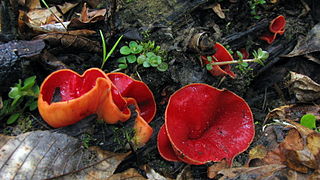
Sarcoscypha austriaca is a saprobic fungus in the family Sarcoscyphaceae of the order Pezizales of Ascomycota. It is commonly known as the scarlet elfcup, pézize écarlate and scharlachroter kelchbecherling. The species name means "from Austria".

Sarcoscypha dudleyi, commonly known as the crimson cup or the scarlet cup, is a species of fungus in the family Sarcoscyphaceae of the order Pezizales. It has been frequently confused with Sarcoscypha coccinea, but can be distinguished from this and other related species in Sarcoscypha by differences in microscopic characteristics, such as the presence and number of oil droplets in the spores. An imperfect form of the fungus, lacking a sexually reproductive stage in its life cycle, is classified as the species Molliardiomyces dudleyi.

Galiella rufa, commonly known as the rubber cup, the rufous rubber cup, or the hairy rubber cup, is a species of fungus in the family Sarcosomataceae. The fungus produces cup-shaped fruit bodies that typically grow in clusters on branches and exposed portions of buried wood throughout eastern and Midwest North America and in Malaysia. The fruit bodies have the texture of tough, gelatinous rubber, and have a rough, blackish-brown, felt-like outer surface and a smooth reddish-brown inner surface. Although generally considered inedible by North American mushroom field guides, it is commonly consumed in Malaysia. The fungus produces several natural products.
